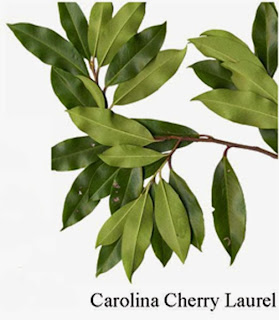"Laurel Leaf" from Stella Rubin's shop
Green leaves with the top three red.
A few weeks ago I did a post about the Laurel Leaf applique block (#5.55 in my Encyclopedia of Applique.) I had not noticed the consistent shading in the 19th-century examples.
Laurel Leaf?
Laurel Leaf
Lady and Laurel Plant by Wencelas Hollar
Virginia Vis pointed out that Laurel plants
do not have red leaves or red flowers.
From a Baltimore Album Quilt dated 1848
Whereas the quilt block universally called Laurel Leaf
almost universally has green leaves and triple red flowers.
Blocks on point
From the Delaware Quilt Project
Virginia, who has done extensive work in identifying the patterns in Baltimore Album Quilts, sent me her " two cents worth:"
"I don't think the red are intended to be flowers. It's a plant that where new/immature leaves are red and then turn green."
Detail of a quilt found in the New Jersey project.
From the Quilt Index
So, Virginia, what is it if not a Bay Laurel?
"My best candidate is the Photinia. Its a southern bush used for hedges. I think its inclusion in the BAQs is another example of regionalism, like including the local monuments."
I don't think Virginia is going to get everyone to start calling the block Photinia. It doesn't have a catchy common name either. "Red tip" probably won't work its way into our quilt block vocabulary.
Photinia fraseri.
The common name is Red Tip Photinia
or Chinese Photinia.
"It's a plant where new/immature leaves are red and then turn green."
Leaves are alternate in both laurels and Photinias.
They aren't paired or opposite as in the quilt block.
But that seems a quibble.
You may have some Photinia in your yard. It's a very showy spring bush. As best I can figure out Photinia is a native of China and Japan and was imported to Europe and America in the early 19th century, where it probably graced the gardens of many an amateur botanist.
Quilt signed Margaret Boone
in the collection of the New England Quilt Mueum




.jpg)








Good analysis on both your parts; this plant shows up often on MD quilts. Now compare quilt's border with this one: http://www.pookandpook.com/cat/2011-10-01/335
ReplyDeleteYour research always fascinates me, Barbara. Luv this Laurel story:)
ReplyDeleteSo my "Sprigs of Laurel Medallion" (not so aptly named by Gerald Roy), is actually a "Sprigs of Photinia Medallion" - but Photinia is also called "Red Robin" - so I could call it a "Sprigs of Red Robin Medallion" - and it doesn't break my heart to drop the name Laurel. I know someone with that name and she's really mean. :)
ReplyDeleteI love this post! Very effective color treatment inspired by nature. Nice to see leaves in other colors. I walk in the woods every day and see all sorts of suble "color" among the endless green.
ReplyDeleteAlso, does anyone recall antique quilts in Laurel pattern where the red leaves look more rounded and flower petal ish? It's probably just my imagination, but seen to recall seeing some rounded red leaves over the years.
P.S. whoops--the close up photo of Baltimore 1848 has rounded red leaves suggesting the maker was thinking of flowers. Either way, lovely pattern.
ReplyDeleteThanks for your thoughtful comments. I'm working on another post about the Laurel Leaves---wondering where the Shelburne's curator got the name. I saw some Frazier Red Tip bushes for sale at the nursery yesterday so I might have to have some. I like Bill's Red Robin name.
ReplyDelete